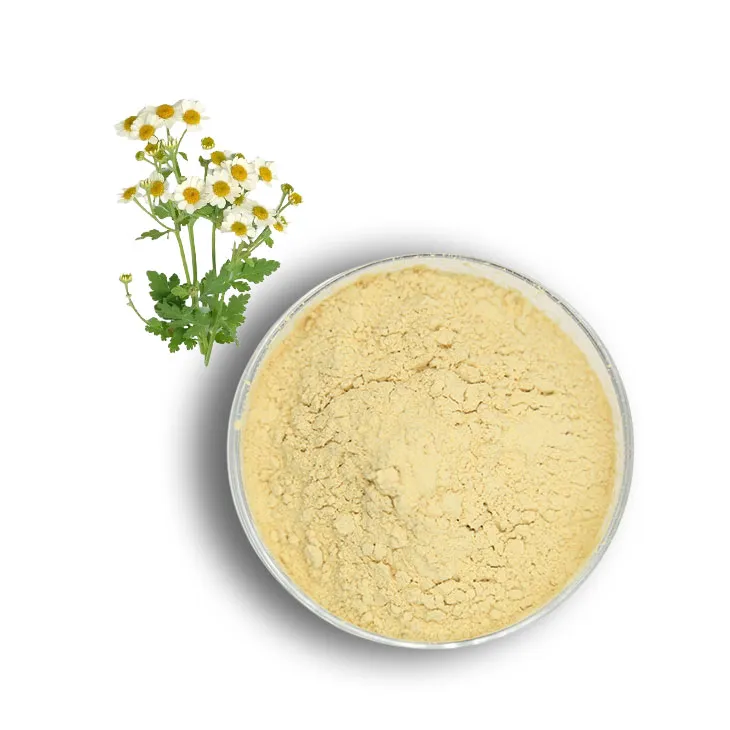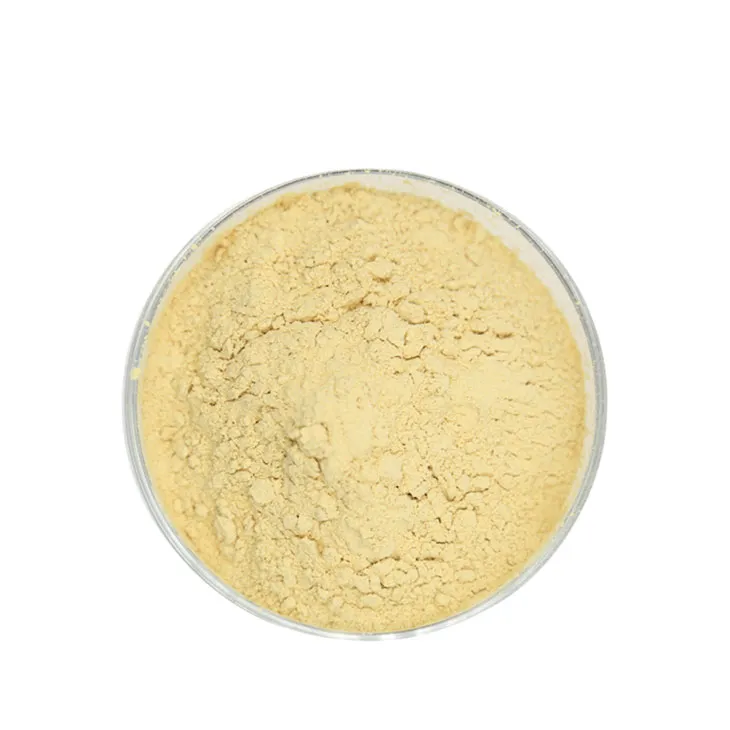- 0086-571-85302990
- sales@greenskybio.com
The process of extracting the medicinal components of feverfew from feverfew extract.
2024-12-01

1. Introduction
Feverfew (Tanacetum parthenium), also known as white chamomile, has been used for centuries in traditional medicine for various health benefits. The extraction of its medicinal components from the plant extract is a complex but crucial process. This article will explore in detail the steps involved in extracting the medicinal components from Feverfew Extract.

2. Selection of Feverfew Source
2.1 Importance of Source Selection
The quality of the feverfew source is fundamental to the extraction of high - quality medicinal components. Organic - grown feverfew is often favored. Organic cultivation methods ensure that the plant is free from pesticides, herbicides, and other contaminants that could potentially affect the purity and safety of the extracted components.
2.2 Considerations in Source Selection
- The geographical origin of the feverfew can also play a role. Different regions may have variations in soil composition, climate, and altitude, which can influence the chemical composition of the plant.
- The stage of growth at which the feverfew is harvested is another important factor. Generally, the plant should be harvested at the optimal time to ensure the highest concentration of the desired medicinal components.

3. Initial Preparation of Feverfew
3.1 Cleaning
Once the feverfew is harvested, it needs to be thoroughly cleaned. This involves removing any dirt, debris, or other foreign matter. Cleaning can be done by gently washing the plant with clean water. However, care should be taken not to damage the plant tissues during this process.
3.2 Drying
After cleaning, the feverfew is dried. Drying helps to reduce the moisture content of the plant, which is important for subsequent extraction steps. There are different methods of drying, such as air - drying, oven - drying, or freeze - drying.
- Air - drying is a traditional method that involves spreading the feverfew in a well - ventilated area. This method is relatively slow but can preserve the natural properties of the plant.
- Oven - drying can be faster, but the temperature and drying time need to be carefully controlled to avoid over - drying or causing thermal degradation of the plant components.
- Freeze - drying is a more advanced method that can better preserve the chemical structure of the plant components, but it is also more expensive.

4. Extraction Methods
4.1 Mechanical Disruption
Before chemical extraction, mechanical disruption of the feverfew is often carried out. This step helps to break the cell walls of the plant, making it easier for the solvents to access the intracellular medicinal components.
One common method of mechanical disruption is crushing. This can be done using a mortar and pestle for small - scale extraction or using mechanical crushers for larger - scale operations. Grinding the dried feverfew into a fine powder can significantly increase the surface area available for extraction.
4.2 Chemical Extraction
After mechanical disruption, chemical extraction is performed using appropriate solvents. A commonly used solvent system is a methanol - water mixture.
The choice of solvent depends on several factors:
- The solubility of the desired medicinal components in the solvent. Different components may have different solubility characteristics, and the solvent should be able to dissolve a wide range of the target components.
- The selectivity of the solvent. It should preferably dissolve the medicinal components while leaving behind unwanted substances such as polysaccharides and proteins.
- The safety and environmental impact of the solvent. Solvents that are less toxic and more environmentally friendly are preferred.
The extraction process typically involves soaking the crushed feverfew in the solvent for a certain period of time, usually several hours to days, at a specific temperature. This allows the medicinal components to dissolve into the solvent.

5. Purification of the Extract
5.1 Liquid - Liquid Extraction
After the initial extraction, the extract contains a mixture of various components. Liquid - liquid extraction can be used to separate different components based on their solubility in different solvents.
For example, if the extract is a mixture of polar and non - polar components, a polar - non - polar solvent pair can be used. The two solvents are mixed with the extract, and after shaking and allowing the phases to separate, the components will partition between the two phases according to their solubility in each solvent.
5.2 Solid - Phase Extraction
Solid - phase extraction is another common purification method. In this method, the extract is passed through a solid adsorbent material, such as silica gel or a polymeric resin.
The adsorbent selectively retains certain components based on their chemical properties, such as polarity or charge. Components that are not retained by the adsorbent are eluted first, followed by the elution of the desired components using an appropriate eluent.
There are different types of solid - phase extraction cartridges available, each designed for specific types of separations. For example, some cartridges are suitable for removing impurities such as pigments and lipids, while others are designed for the purification of specific classes of medicinal compounds.

6. Characterization and Quantification of the Extracted Components
6.1 Analytical Techniques
To ensure the pharmaceutical value of the extracted and purified medicinal components, advanced analytical techniques are used for characterization and quantification.
High - performance liquid chromatography (HPLC) is a widely used technique. HPLC can separate the components in the extract based on their different affinities for the stationary and mobile phases in the chromatographic column. By using appropriate detectors, such as UV - Vis detectors or mass spectrometers, the individual components can be detected, identified, and quantified.
Gas chromatography - mass spectrometry (GC - MS) is another powerful technique, especially for analyzing volatile components. In GC - MS, the components are first vaporized and then separated by gas chromatography. The separated components are then analyzed by mass spectrometry, which provides information about their molecular weights and structures.
Nuclear magnetic resonance (NMR) spectroscopy can also be used to determine the chemical structures of the extracted components. NMR provides detailed information about the connectivity of atoms in a molecule, which is useful for identifying and characterizing complex medicinal compounds.
6.2 Importance of Characterization and Quantification
Characterization and quantification are essential for several reasons.
- They ensure that the extracted components are of the correct chemical identity and purity. This is crucial for pharmaceutical applications, as any impurities or incorrect components could affect the safety and efficacy of the final product.
- Quantification allows for the determination of the concentration of the medicinal components in the extract. This information is important for formulating the correct dosage of the medicinal product.
- By characterizing and quantifying the components, it is possible to compare different batches of extracts and ensure consistency in the quality of the final product.
7. Conclusion
The extraction of medicinal components from Feverfew Extract is a multi - step process that involves careful selection of the source, proper preparation of the plant, effective extraction methods, purification of the extract, and thorough characterization and quantification of the final components. Each step is crucial in ensuring the quality and pharmaceutical value of the extracted components. With the increasing demand for natural - based medicinal products, the development and optimization of these extraction processes will continue to be an important area of research.
FAQ:
What are the main factors to consider when choosing the source of white chamomile?
When choosing the source of white chamomile, the main factor to consider is its quality. Organic - grown white chamomile is often preferred as it is likely to have a higher quality, which may result in better extraction of medicinal components.
Why is mechanical disruption necessary in the extraction process?
Mechanical disruption, such as crushing, is necessary in the extraction process because it can break the cell walls of white chamomile. By breaking these cell walls, it becomes easier to release the medicinal components trapped inside the cells, thus facilitating the extraction process.
What are the advantages of using methanol - water mixtures as solvents in chemical extraction?
Methanol - water mixtures can be effective solvents in chemical extraction. The advantage is that they can dissolve a wide range of medicinal components present in white chamomile. Different components may have different solubilities in the methanol - water mixture, which helps in the extraction process.
How does liquid - liquid extraction separate different components?
Liquid - liquid extraction separates different components based on their solubility in different solvents. Components with different solubilities will partition between the two liquid phases. This allows for the separation of various medicinal components from the white chamomile extract.
What is the role of solid - phase extraction in the purification process?
Solid - phase extraction is a common purification method. It works by adsorbing certain components onto a solid phase while allowing others to pass through. This helps in removing impurities and further purifying the extracted medicinal components from white chamomile.
Related literature
- Medicinal Plants: Extraction and Analysis of Bioactive Compounds"
- "Advances in the Extraction and Purification of Plant - based Medicinal Components"
- "The Chemistry and Pharmacology of White Chamomile: An Overview"
- ▶ Hesperidin
- ▶ Citrus Bioflavonoids
- ▶ Plant Extract
- ▶ lycopene
- ▶ Diosmin
- ▶ Grape seed extract
- ▶ Sea buckthorn Juice Powder
- ▶ Fruit Juice Powder
- ▶ Hops Extract
- ▶ Artichoke Extract
- ▶ Mushroom extract
- ▶ Astaxanthin
- ▶ Green Tea Extract
- ▶ Curcumin
- ▶ Horse Chestnut Extract
- ▶ Other Product
- ▶ Boswellia Serrata Extract
- ▶ Resveratrol
- ▶ Marigold Extract
- ▶ Grape Leaf Extract
- ▶ New Product
- ▶ Aminolevulinic acid
- ▶ Cranberry Extract
- ▶ Red Yeast Rice
- ▶ Red Wine Extract
-
Lemon Balm Extract
2024-12-01
-
Angelica sinensis extract
2024-12-01
-
Scutellaria Extract
2024-12-01
-
Mangosteen extract powder
2024-12-01
-
Buckthorn bark extract
2024-12-01
-
Acerola Extract
2024-12-01
-
Hawthorn powder
2024-12-01
-
Motherwort Extract
2024-12-01
-
Resveratrol extract
2024-12-01
-
Nettle Root Extract
2024-12-01





















